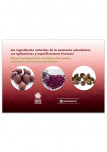Marcela Piedad Carrillo Bautista
Juliana Erika Cristina Cardona Jaramillo
Raquel Oriana Díaz Salcedo
Luisa Lorena Orduz Díaz
Luisa Fernanda Peña Rojas
María Soledad Hernández Gómez
Luis Eduardo Mosquera Narváez
Book
2017
978-958-59513-8-9
4 inks
114 pages

Biodiversity has been universally recognized as the variability of living organisms from any source, including terrestrial and marine ecosystems and other aquatic ecosystems, as well as the ecological complexes found within them, and includes the diversity within each species, between species and from ecosystems. Its conservation is in the common interest of all humanity, which is why the Convention on Biological Diversity (CBD) was ratified on December 29, 1993 as a biding international treaty with the proposed principles of sustainable use and the fair and equitable distribution of the benefits derived from the use of genetic resources. In this framework, sustainable use is defined as the use of biodiversity in a manner and timing that do not result in decreases in the long-term, which makes it possible for it to continue to satisfy the needs and aspirations of current and future generations (Convention on Biological Diversity-CBD1).
Colombia is considered a mega-diverse country that contains approximately 10% of the different known life forms on only 0,7% of the planet’s surface (Chaves and Arango, taken from PNGIB 2009); the Amazon region is the 42,42% (483,164 km2) and 6,21% of the Amazon bioregion; therefore, it has a rich biological diversity with great potential for exploitation, processing and commercialization.
This rich biodiversity includes non-timber forest products (NTFP), many of which have natural abundance in the Amazon forests, which are used by indigenous communities for traditional purposes such as food, construction material, making crafts, medicines, among others, and great phytochemical wealth, creating an opportunity for sustainable use. NTFP are obtained through the sustainable use of flora, which, because they are not classified as timber products, represent a biocommerce subsector that, nationally, falls in the category of Sustainable Goods and Services from natural resources of the “National Plan for Green Businesses” for Colombia2.
This publication presents the results of scientific research conducted by the SINCHI Institute on the physical, chemical and biological activity (the methodologies are presented at the end of this document)of some NTFP found in the forests of the Colombian Amazon, and on their natural ingredients that are obtained therefrom. These ingredients, along with sustainable management strategies (use plans), represent an option for the development of environmentally, economically and socially sustainable productive alternatives that tend to the welfare of Amazonian communities and the conservation of biodiversity.